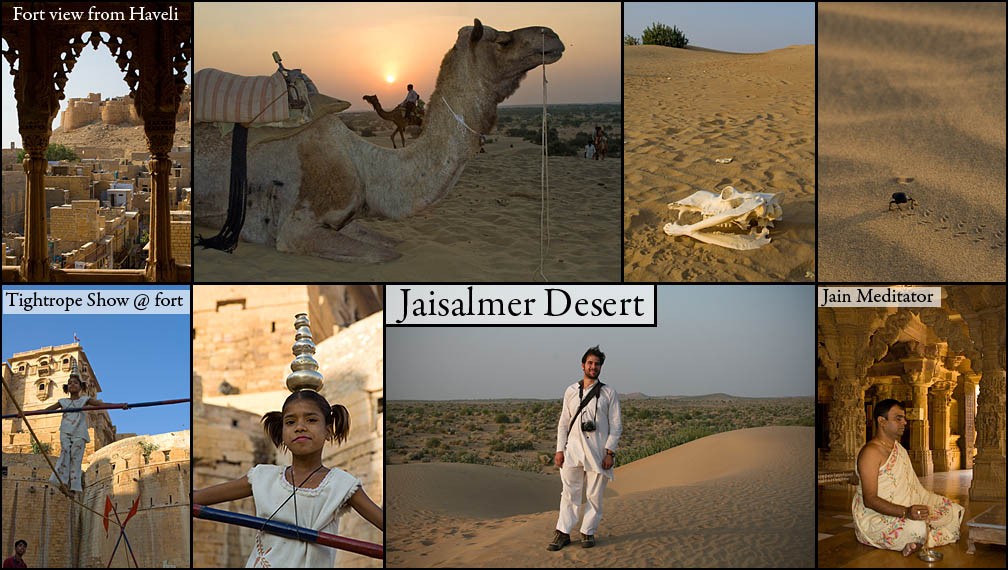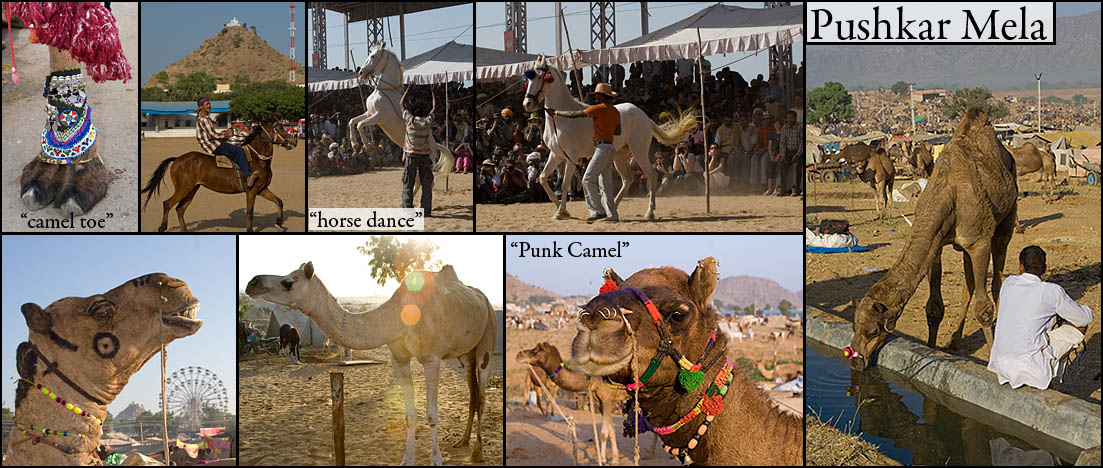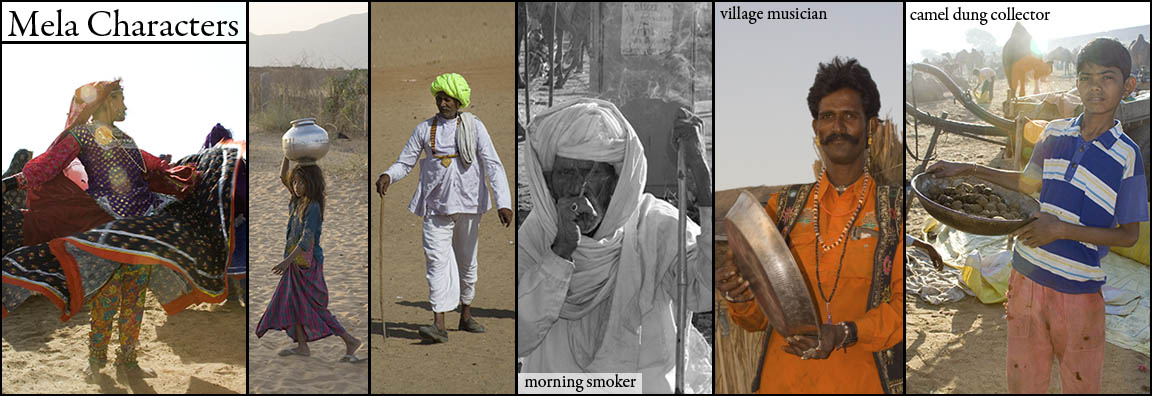

|
All Photographs © Sam Oppenheim
|
|||||||||||||
| ||||||||||||||
| |||||||||||||||||
|
"Know the true value of time! Snatch, seize, and enjoy every moment of it. No idleness, no laziness, no procrastination. Never put off until tomorrow what you can do today" - Philip Chesterfield IV. ---- UDAIPUR I had heard so much about this town famous for the floating lake palace that I figured it would certainly disappoint me. It didn't! 2 nights and 1.5 days left me exhausted from "Doing it all". One morning I drove up to The Monsoon Palace. Built atop a hill overlooking the whole region the farmland and forest are arrayed below. This palace, now abandoned, was ghostly empty and decaying, yet beautiful. Next, the central City Palace was like all other Rajasthani Palaces - ornate and filled with guided tours, but so opulent it is a must-see. |
|||||||

|
|||||||
At sunset I ran to the waterfront to photograph the lake palace, but missed the last ferry. Determined, I hired a plastic paddle-boat and began pedaling in earnest until I was sweating like a woman giving birth, could barely see through salty-eyes, and then pushed on some more. Now was not the time for turning back. The golden-honey last light of the sun painted the palace and was fading fast. Circling the palace completely for maximum photographic potential, I finally got my "money shot" when the sun dipped behind Mother Earth alongside the palace. Next thing I knew, I was getting yelled at by a motorboat that almost sunk me. Apparently I was too far from shore for a plastic dinghy. |
|||||||

|
|||||||
Back on land I was congratulated on my seamanship by the rental agency, and offered a backrub. Exhausted from cycling 2-3 miles through water I couldn't resist an Ayurvedic massage for just $5.00. Then I watched a traditional dance performance held nightly in a restored Haveli (Nobleman's lakeside mansion). What a spectacle! Don't try this at home: dancing on broken glass, balancing fires, towering pots on heads, and all the while jingling bells & bangles. V. ---- MT. ABU This mountain vacation spot in the middle of a fertile valley reminds me of Mt. Diablo in California. Mt. Abu dominates the landscape and may similarly be an old volcano. People visit it for the cooler climate, a beautiful mountaintop lake, and the magnificently carved white marble Jain temple. Again I wished I had stayed longer, but I did see it all. Darling couples held hands walking or cuddled in boats. I saw no foreigners on my whole walk around the lake. Cameras are not allowed inside the gorgeous temple renowned as India's best stone carving, so you'll have to go yourself! Like Jodhpur's farm, the highlight for me was an encounter with the locals. I snapped photos from a distance of some shy women working on building a dam. When I approached them they were reluctant to be photographed, so I helped the build the dam. It was fun, even though I had difficulty balancing the dirt on my head, and I gained their trust! Later I returned from a walk and brought them cold bottled water and mango juice. Last month I mailed them copies of their photographs. |
|||||||

|
|||||||
I ended my last night at sunset point. It was nice to see the last rays of red glint off reservoirs and set behind a seemingly infinite expanse of flat farmland, but more interesting was crowd watching. Leaving after sunset was like Time's Square on New Year's Eve, but with horses, too! I nearly got trampled photographing the crowd with my back to the flow. They yelled "ghora!" (horse) and i stupidly thought they were saying "gora," which means white man! VI. ---- JAISALMER Jaisalmer is India's last fort on the edges of the Thar Desert. It is an outpost of a lost kingdom, near the border with present-day Pakistan. The area is famous for camel safaris, but it is most unique for being Rajasthan's only living fort. Unlike the museum-preserved edifices in other areas, this fort is filled with privately owned houses and occupied day and night as a city within walls above the desert. Walking the crenellated rampart walls was peaceful, and wandering inside the city was pleasant, but visiting the ancient Jain temples was exquisite. I checked out the local desert one night and a lake far below the fort on my last evening. |
|||||||

|
|||||||
Before leaving town I also went to the famous government Bhang shop. This one sold not only marijuana-lassi drinks, but also marijuana-pineapple-juice, and pot-cookies. All legal and government certified. However, this is one of the only places where marijuana is legal in all of India. As I sat inside the shop with other patrons, I asked the owner about the cookies. He took out two airtight bins and opened them. "These are normal strength for normal people," he said of the first. Then opening the box of noticeably darker and tougher cookies, he explained, "These are for Israelis and camels!" We laughed - even the Israelis. Then I asked, "Oh, you mean for eating while on a camel safari, right?" "Ah, yes, it is good to have on a safari also," he began, "When you eat you feel like on flying carpet, not stinky bumpy camel - the desert is more beautiful then, too. But also to feed to camel. They, too, like to eat. When your camel has strong cookie he walks more smooth, no more bump-bump. It is like camel swimming in oasis under moonlight." VII. ---- THE PUSHKAR MELA Once a year Pushkar - a small dusty town surrounding a holy lake - explodes with tourists while hosting a huge festival. There are 3 parts to the event. First there is the 4-day animal market where camels, horses, and other livestock are shown and sold. Secondly, the government, to encourage tourism, began hosting daily entertainment events and even built a stadium on one side of the town. Finally, on the last day at sunrise after the full moon in November, every Hindu, including many holy men, take a dip in the lake to cleanse their body and soul. |
|||||||

|
|||||||
Wandering around, it at times reminded me of the Kumbha Mela - tents, crowds, dust, animals, street food - but not as interesting. The municipal stadium, however, hosted great fun events including buffalo milking competitions, camel races, mustache-pulling-a-car, water-filled-earthen-pot relay races, horse dances, tug of war, and every night a plethora of talent showcased on a bandstand. |
|||||||

|
|||||||
I participated in the tug-of-war foreigners vs. Indians, and a pot-breaking contest. Afterward I was featured on TV as the turbaned Hindi-speaking American and enjoyed some degree of notoriety. On my return journey locals recognized me on the train platform, and asked me a barrage of questions about my being on TV and knowing Hindi. |
|||||||

|
|||||||
Other highlights included renting a scooter, tying tefillin in a local Hasidic Jew outpost, and playing with a baby goat some fellow borders in my hostel bought as a pet. I also visited a local village one afternoon where an adorable old man in pink danced with his wife while friends improvised instruments. One day I met a fellow Columbia Alum at sunset on a temple-topped hill. Overall, Pushkar was really fun and at times crazy. |
|||||||

|
|||||||
The last 2 days, after all the animal sellers had packed up their tents and started their long march home, sometimes a week by foot, yet there were still many tourists. Finally the crowds built up to a crescendo on the final day. All the streets became safety hazards. Only foot traffic was allowed, and it was regulated by police into one-way paths. I returned my rented scooter and fought the crowds clutching my wallet and camera bag tightly. Photography is forbidden at the ghats (steps to water) to respect bathing women, but I took some anyway from a distance, and others with the explicit permission of holy men. |
|||||||

|
|||||||
Finally I left Rajasthan, exhausted, with some sights unseen including the "Rat-Temple", but overall feeling very successful at photographically documenting most of the state. "How you spend your time is more important than how you spend your money. Money mistakes can be corrected, but time is gone forever" - David Norris |